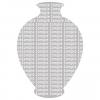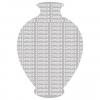Pair of Japanese Gilt Bronze Koma-Inu by Ishikawa Komei
- 镀金
The pair well cast, and robustly modeled. They are portrayed seated on their haunches, with broad, muscular chests, long, flowing manes, and a flame-like tails. The rich gilding further highlighting the strong musculature of these beasts. Their sharp faces, ending in wide, flattened ruyi shaped noses, and mouths set in almost mischievous grins.
Near mirror images, the figures differ only slightly. One lion has his ears pitched forward, and his mouth open, symbolizing the Sanskrit seed syllable "ah" ("a" in Japanese). The other lion has his ears standing upright, and his mouth closed, symbolizing the Sanskrit seed syllable "om" ("um" in Japanese). Together, these two sounds are said to encompass the entire universe, and are equivalent to the Greek "alpha" and "omega".
These lions are based on a pair, carved in wood and dating to the Kamakura period (1185-1333), that originally guarded the Taiho Shrine, Shiga Prefecture, and are now housed in the Kyoto National Museum.
Also known as karashishi, or simply shishi in Japan, in the west they are commonly referred to as foo dogs or foo lions. These ferocious creatures are considered guardians of sacred spaces, and are usually placed at the entrance to shrines or temples.
A nine character inscription in Chinese seal script has been cast to the underside of each lion, reading "Teishitsu gigeiin Ishikawa Komei" (Imperial Artist Ishikawa Komei).
Ishikawa Komei (1852 - 1913) was a renowned Meiji Period artist, known mostly for his carved works in ivory, though he worked across a wide spectrum of media, including bronze, plaster, and paint. Originally trained as a painter of the Kano school, he taught as a professor at the Tokyo School of Fine Arts, where a bust in his honor stands today. When the Imperial Artist system was implemented in 1891, Komei was one the first to receive the honored title. His bronze works are considered quite rare.




